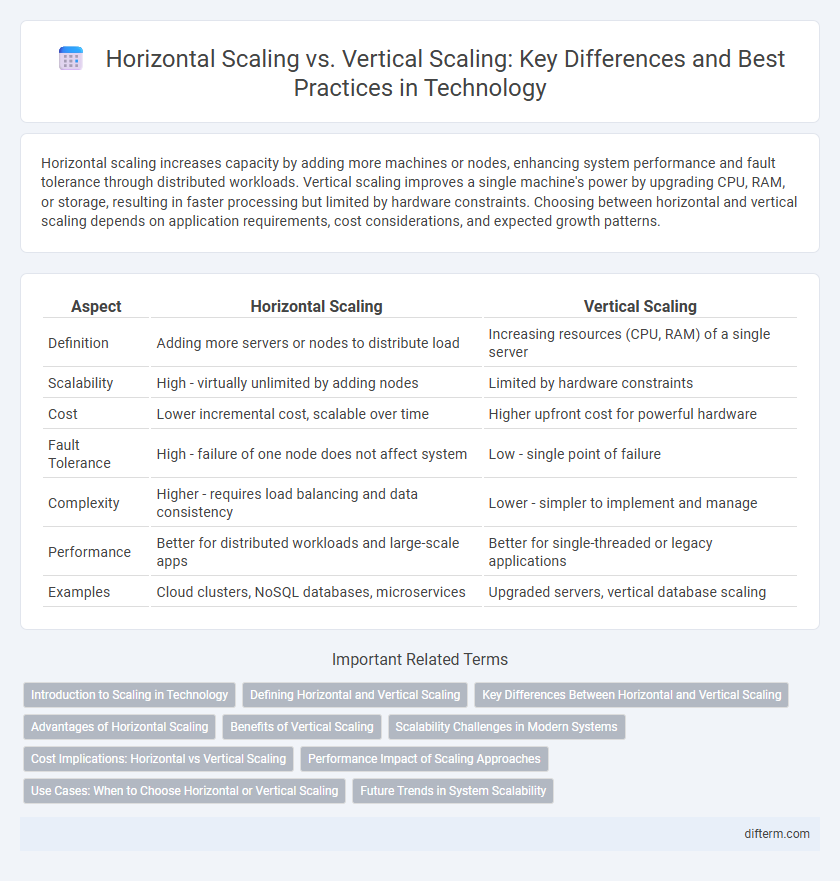Horizontal scaling increases capacity by adding more machines or nodes, enhancing system performance and fault tolerance through distributed workloads. Vertical scaling improves a single machine's power by upgrading CPU, RAM, or storage, resulting in faster processing but limited by hardware constraints. Choosing between horizontal and vertical scaling depends on application requirements, cost considerations, and expected growth patterns.
Table of Comparison
| Aspect | Horizontal Scaling | Vertical Scaling |
|---|---|---|
| Definition | Adding more servers or nodes to distribute load | Increasing resources (CPU, RAM) of a single server |
| Scalability | High - virtually unlimited by adding nodes | Limited by hardware constraints |
| Cost | Lower incremental cost, scalable over time | Higher upfront cost for powerful hardware |
| Fault Tolerance | High - failure of one node does not affect system | Low - single point of failure |
| Complexity | Higher - requires load balancing and data consistency | Lower - simpler to implement and manage |
| Performance | Better for distributed workloads and large-scale apps | Better for single-threaded or legacy applications |
| Examples | Cloud clusters, NoSQL databases, microservices | Upgraded servers, vertical database scaling |
Introduction to Scaling in Technology
Scaling in technology refers to the ability of a system to handle increased load by expanding resources. Horizontal scaling involves adding more machines or nodes to distribute the workload, enhancing fault tolerance and capacity. Vertical scaling upgrades the existing hardware's capabilities, such as CPU, RAM, or storage, improving performance within a single system.
Defining Horizontal and Vertical Scaling
Horizontal scaling involves adding more servers or machines to distribute workloads, enhancing system capacity by expanding infrastructure laterally. Vertical scaling increases the resources of a single server, such as CPU, RAM, or storage, to handle higher demand within the existing hardware. Both strategies aim to improve performance and accommodate growth, but horizontal scaling offers better fault tolerance and flexibility, while vertical scaling provides simplicity and lower upfront costs.
Key Differences Between Horizontal and Vertical Scaling
Horizontal scaling involves adding more machines or nodes to a system, enhancing capacity by distributing workloads across multiple servers for improved fault tolerance and redundancy. Vertical scaling boosts a single machine's resources, such as CPU, RAM, or storage, to handle increased demand without changing the system's architecture. Key differences include cost efficiency and flexibility, where horizontal scaling offers better fault tolerance and scalability for cloud-native applications, while vertical scaling often demands downtime and hardware limits but simplifies management.
Advantages of Horizontal Scaling
Horizontal scaling enhances system performance by adding multiple servers or nodes, enabling better load distribution and improved fault tolerance. It supports seamless expansion and high availability without significant downtime, making it ideal for cloud environments and distributed databases. This scalability approach also reduces bottlenecks by preventing single points of failure, ensuring consistent and reliable service delivery.
Benefits of Vertical Scaling
Vertical scaling enhances system performance by upgrading existing hardware components such as CPUs, memory, and storage, enabling faster data processing and reduced latency. It simplifies management by maintaining a single server environment, lowering complexity and administrative overhead. This approach is cost-effective for applications with predictable growth and high resource demands, avoiding the need for complex distributed architectures.
Scalability Challenges in Modern Systems
Horizontal scaling involves adding more machines to distribute workloads, which enhances fault tolerance but introduces challenges in data consistency and network latency. Vertical scaling increases the capacity of a single machine by upgrading CPU, RAM, or storage, yet faces limitations due to hardware constraints and potential single points of failure. Modern systems struggle with balancing the trade-offs between these approaches to maintain high availability, efficient resource utilization, and seamless scalability under variable loads.
Cost Implications: Horizontal vs Vertical Scaling
Horizontal scaling often leads to lower long-term costs by distributing workloads across multiple low-cost machines, reducing the risk of single points of failure and enabling incremental capacity expansion. Vertical scaling involves upgrading existing hardware, which can become expensive as high-end servers or components carry premium prices and may face physical or performance limits. Organizations must evaluate trade-offs between upfront investment in powerful infrastructure and ongoing maintenance expenses when choosing between horizontal and vertical scaling strategies.
Performance Impact of Scaling Approaches
Horizontal scaling improves performance by distributing workload across multiple servers, enhancing fault tolerance and allowing seamless capacity expansion without downtime. Vertical scaling increases a single server's resources, such as CPU and RAM, boosting performance for resource-intensive applications but facing limits due to hardware constraints. The choice between horizontal and vertical scaling significantly impacts system responsiveness and availability, with horizontal scaling offering greater flexibility for handling growing workloads.
Use Cases: When to Choose Horizontal or Vertical Scaling
Horizontal scaling is ideal for applications requiring high availability and fault tolerance, such as distributed databases, large-scale web services, and cloud-native microservices architectures. Vertical scaling suits workloads with limited parallelism or legacy systems where increasing CPU, RAM, or storage on a single server boosts performance without code changes. Choosing between horizontal scaling and vertical scaling depends on factors like cost efficiency, system complexity, and the need for elasticity in handling variable traffic patterns.
Future Trends in System Scalability
Future trends in system scalability emphasize hybrid approaches combining horizontal scaling, which distributes workloads across multiple servers, with vertical scaling, enhancing individual server capacity for optimal performance. Advances in cloud-native technologies and container orchestration platforms like Kubernetes facilitate dynamic resource allocation, promoting seamless scalability in real-time applications. AI-driven predictive analytics are increasingly enabling proactive scaling decisions, ensuring systems adapt efficiently to fluctuating demand patterns while minimizing latency and operational costs.
Horizontal Scaling vs Vertical Scaling Infographic

 difterm.com
difterm.com